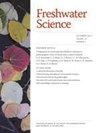Heterogenous distribution of kākahi (freshwater mussel Echyridella menziesii) environmental DNA in 5 New Zealand lakes of differing size and geomorphology
IF 1.6
4区 环境科学与生态学
Q3 ECOLOGY
引用次数: 2
Abstract
The abundance of freshwater mussels is declining globally. To better understand and possibly reverse this trend, we need more information on the occurrence and distribution of freshwater mussels. Using environmental DNA (eDNA) to detect species is a sensitive and cost-effective approach that can complement conventional monitoring methods. The quantity and distribution of eDNA in a waterbody determines how many samples researchers need to collect for a successful survey. There has been limited research on appropriate sampling strategies for detecting freshwater mussel eDNA in lakes. The aim of this study was to compare the occurrence and concentration eDNA from the New Zealand freshwater mussel or kākahi (Echyridella menziesii Gray, 1843) with density data obtained from divers and to use statistical approach to determine the optimal number of samples required when establishing a monitoring program. We took surface-water samples for eDNA detection from 5 lakes of different size and depth. At the same locations, divers measured kākahi density using traditional transects. For eDNA, we amplified the mitochondrial cytochrome oxidase 1 gene using droplet digital polymerase chain reaction. All 5 lakes had substantial populations of kākahi and high eDNA occupancy (79%). We detected kākahi eDNA at both shallow and deep sites. Detectability (presence/absence) of kākahi eDNA varied between 61 and 96% and was generally higher in shallow small lakes which is likely related to the lake’s geomorphology. Our models indicated that sampling 4 sites in triplicate is sufficient to detect kākahi eDNA if occupancy is high (>80%), but the number of sites sampled needs to be increased in lakes where there is no prior knowledge on kākahi populations. The results of this study provide guidance that can be used to inform development of sampling strategies for kākahi monitoring in lakes.kākahi(淡水贻贝Echydella menziesii)环境DNA在新西兰5个不同大小和地貌湖泊中的异质分布
全球淡水贻贝的数量正在下降。为了更好地了解并可能扭转这一趋势,我们需要更多关于淡水贻贝的发生和分布的信息。使用环境DNA(eDNA)检测物种是一种敏感且具有成本效益的方法,可以补充传统的监测方法。水体中eDNA的数量和分布决定了研究人员需要收集多少样本才能成功进行调查。关于检测湖泊中淡水贻贝eDNA的适当采样策略的研究有限。本研究的目的是将新西兰淡水贻贝或kākahi(Echydella menziesii-Gray,1843)的eDNA的发生率和浓度与从潜水员那里获得的密度数据进行比较,并使用统计方法确定建立监测程序时所需的最佳样本数。我们从5个不同大小和深度的湖泊中采集了地表水样本进行eDNA检测。在同一地点,潜水员使用传统的样带测量了kākahi的密度。对于eDNA,我们使用液滴数字聚合酶链式反应扩增线粒体细胞色素氧化酶1基因。所有5个湖泊都有大量的kākahi人口,eDNA占有率很高(79%)。我们在浅层和深层都检测到了kākahi eDNA。kākahi eDNA的可检测性(存在/不存在)在61%至96%之间变化,在浅水小湖中通常更高,这可能与湖泊的地貌有关。我们的模型表明,如果占有率很高(>80%),一式三份对4个地点进行采样就足以检测出kākahi eDNA,但在事先不了解kāka hi种群的湖泊中,需要增加采样地点的数量。这项研究的结果提供了指导,可用于制定湖泊中kākahi监测的采样策略。
本文章由计算机程序翻译,如有差异,请以英文原文为准。
求助全文
约1分钟内获得全文
求助全文
来源期刊

Freshwater Science
ECOLOGY-MARINE & FRESHWATER BIOLOGY
CiteScore
4.10
自引率
0.00%
发文量
49
审稿时长
6-12 weeks
期刊介绍:
Freshwater Science (FWS) publishes articles that advance understanding and environmental stewardship of all types of inland aquatic ecosystems (lakes, rivers, streams, reservoirs, subterranean, and estuaries) and ecosystems at the interface between aquatic and terrestrial habitats (wetlands, riparian areas, and floodplains). The journal regularly features papers on a wide range of topics, including physical, chemical, and biological properties of lentic and lotic habitats; ecosystem processes; structure and dynamics of populations, communities, and ecosystems; ecology, systematics, and genetics of freshwater organisms, from bacteria to vertebrates; linkages between freshwater and other ecosystems and between freshwater ecology and other aquatic sciences; bioassessment, conservation, and restoration; environmental management; and new or novel methods for basic or applied research.
 求助内容:
求助内容: 应助结果提醒方式:
应助结果提醒方式:


